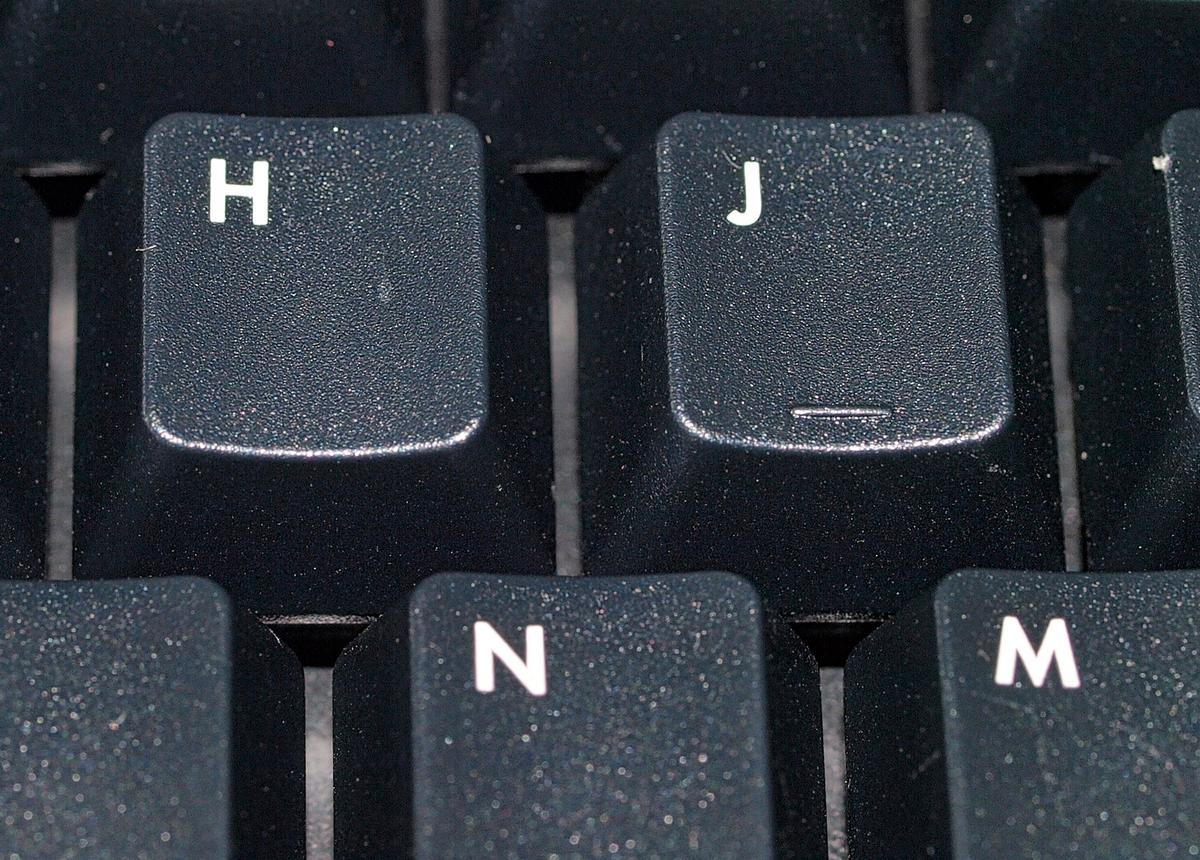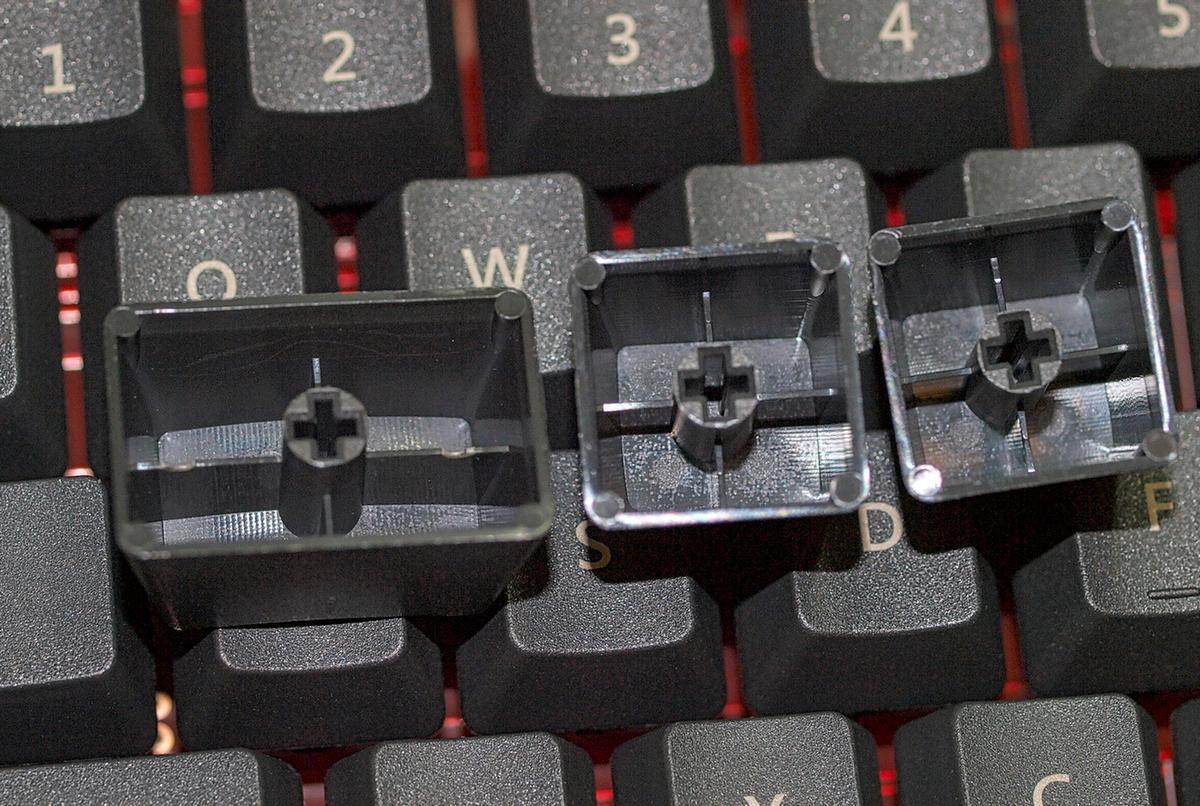ABS vs PBT Keycaps: What’s the Difference?
Whether you assemble your own keycaps or buy a pre-made one, the question “ABS vs PBT keycaps?” comes up in both cases. This is because ABS and PBT are the two most commonly used polymers in the manufacture of keycaps. Both types of polymer have a different look, feel, as well as a different sound. In the past, ABS keycaps were considered the inferior option and PBT keycaps the ultimate, but nowadays it’s not so easy to judge.
But what exactly are the differences between the two materials used for your keyboard’s keycaps? We tackle the topic of ABS vs. PBT keycaps here and explain everything you need to know about it.
What are ABS Keycaps?
ABS keycaps are the standard. ABS stands for Acrylonitrile Butadiene Styrene and is a mixture of different materials. ABS polymer can be easily melted down and molded, making it an extremely flexible and easy to work with polymer. Despite these properties, ABS is still relatively durable and resistant, but cheap to manufacture. Due to its lower manufacturing cost and ease of fabrication, ABS keycaps can still be found on most gaming keyboards, even high-end models.

ABS is also shock resistant, so the keycaps can easily withstand a few million keystrokes before you see signs of wear. One of the biggest drawbacks of ABS, however, is that it wears out faster than PBT. As a result, it’s not uncommon for the lettering on an ABS keycap to start fading after heavy use and for the material to thin. In addition, ABS keycaps have thinner walls, making them even more vulnerable and brittle.
Nevertheless, there are now also sturdier ABS variants, which is why this circumstance is somewhat less of an issue. These special ABS keycaps have thicker walls, but are very expensive, which puts the whole thing into perspective again. But even today, most mechanical keyboards still rely on inexpensive ABS keycaps.
In terms of feel, ABS keycaps are much smoother in texture. Some people rather like the smooth surface, as this can be pleasant especially when typing, when you quickly dart your fingers over the keyboard. However, the second disadvantage of ABS also comes into play here, because poorly manufactured ABS keycaps take on a shiny or greasy-looking surface more quickly. This is not only visually unattractive, but also makes for less grip when using the keyboard. They also fade faster when exposed to sunlight and can gradually lose their color. This also applies to high-quality ABS keys.
The latter is also related to the fact that most ABS keycaps are manufactured by the injection molding process and the inscription is then completed with a cheap laser engraving or, in the worst case, just printed on. This often leads to the inscriptions of individual keys becoming less legible after longer use. However, this only happens with inexpensive keyboards, especially since the double-shot process is also increasingly used for engraving ABS keycaps, which prevents the lettering from fading.
What are PBT Keycaps?
Polybutylene terephthalate (PBT) keycaps are a less common material for keycaps compared to ABS. PBT keycaps are generally more expensive to manufacture, but they are also more durable and sturdy than their ABS counterpart. They also have a more brittle and rough texture, which is why they feel different.

In addition, PBT polymer is more resistant to friction and heat than ABS, but its material properties also make it more difficult to mold in production. In addition, the specific production process for PBT keycaps requires thicker walls. Due to the harder surface structure, there is hardly any wear and tear on PBT keycaps and you can use them for a long period of time before you see any signs of it.
Characteristic of PBT keycaps are the rough, sometimes sandy textured feel. Usually, however, more expensive PBT keycaps have a softer texture than cheaper versions. Also, PBT keycaps tend to be matte, not shiny, and are less susceptible to fingerprints.
There are also quality and price differences in PBT keycaps, but they don’t matter as much. You have to cut back on the design in cheaper variants, especially since the color accuracy and color brilliance are not perfectly implemented. In addition, deformed keycaps are more likely to occur here, but this does not happen often.
You’ll find more unique designs and colors in premium PBT sets. The above-mentioned problems do not occur anymore due to higher quality standards, but you do not see any differences in terms of material quality and longevity.
ABS vs PBT Keycaps: The most Important Differences
Now that we’ve explained the two main types of polymer, let’s talk about the biggest differences between ABS and PBT. When comparing PBT and ABS, there are a few facts. Apart from that, other things like cost and thickness of the keycaps depend on the manufacturer. The following overview summarizes the most important things:
| ABS Keycaps | PBT Keycaps |
|---|---|
| Usually Cheaper | More Expensive |
| Glossy surface | Matte surface |
| Smooth | Textured |
| Thinner | Thicker |
| Quieter when typing | Louder when typing |
| Flexible | Brittle |
| Wears out faster | Durable and longer lasting |
Texture
ABS keycaps wear with use, making the surface of the cap shinier and more slippery. Especially with frequently used keys like WASD, the shining will become noticeable faster and will make your keyboard look weird so quickly. How quickly your ABS keys become shiny depends on the usage level, but you can expect it after half a year.
PBT keycaps, on the other hand, retain their matte texture and appearance for a much longer period of time. This is due to the different polymer materials and compounds used in each type. Some high-quality ABS keycaps can get around this problem, but they are more expensive and will need to be replaced.
Price
Typically, PBT keycaps are more expensive than ABS. This is because PBT keycaps are much more difficult to manufacture, as the material is more complicated to mold during injection molding. Some ABS keycaps may even cost more than PBT keycaps, but these are special sets with unique design and thicker material.
Sound
When using PBT keycaps, you quickly notice that they have a different sound when typing. They are usually a bit louder than ABS, but the sound is somehow crisper, tactile and “cleaner”. Since the PBT material is stiffer and thicker, the keycaps themselves don’t vibrate as much, which makes for the crisper sound.
ABS is a softer polymer and produces a quieter, more subtle sound. Neither is better, but a matter of taste. Some like the more tactile sound of PBT, some love the quieter strokes with ABS.
Material & Density
PBT keycaps are made of a different type of polymer that is more brittle, durable, and textured than ABS. Because of this, PBT keycaps are usually thicker than ABS keycaps. Nevertheless, ABS sets with thicker walls are now available for purchase, but they are expensive.
PBT tends to deform when cooling, which can lead to bent keycaps. So pay close attention to this with your keyboard and make use of your warranty.
Design & Colors
ABS keycaps often have a wider range of colors and offer many more design options from different manufacturers. ABS is easier to mix with colors and also makes them appear a bit more gaudy. PBT keycaps also have some color selection, though you’re less likely to find very bright colors here, but rather matte and set hues.
So, which is better, PBT or ABS? As you can see from the comparison, it’s a matter of taste. You have to decide whether a matte surface and durability are more important to you than bright colors, a (often) lower price and quieter strokes.
Labeling Method
Apart from the different materials, there are also differences in the lettering of the keyboard. This also affects how high-quality the keycaps appear and, above all, how well the lettering holds on the key. There are four different ways to inscribe the keycaps.
Pad Printing
This is the cheapest and therefore also the least durable variant of keyboard labeling. A pad is printed with the corresponding inscription and then glued to the key. As you can imagine, this variant is not particularly durable, as the pad wears out over time and the lettering is lost. Some manufacturers therefore cover their keycaps with a coating to delay the wear process a bit. However, this method is not usually used for mechanical keyboards, where the manufacturers at least use laser etching or even higher-quality labeling processes.
Laser Etching
With this method, the inscriptions are engraved into the key by laser. The outside of the key cap is often completely covered with paint, into which the inscription is then engraved. This makes them much more durable than pad-printed keys, but even engraved keys can wear out. It often happens that the ink around the lettering is also worn off during longer use, which makes the lettering itself no longer perfectly legible.
Dye Sublimation
Here, you print the lettering onto the keycap and by applying heat, both parts are fused together, making the lettering last for a very long time. Wear and tear is minimal because the lettering and keycap are effectively one component after heat application and the lettering cannot be removed.
Double Shot
This is the highest quality method for marking keycaps. Here, the inscription is not printed on the key afterwards by any process, but the inscription takes place directly during the manufacturing process. In a first step, the keycap is cast in a mold, and there is a recess for the labeling. This gap is then closed with a second casting. Thus, the actual keycap and lettering are made of two different materials, but they are firmly fused together. This makes it virtually impossible for the labeling to wear out, since the entire material of the outer casting would have to wear out. This marking process can be used for both ABS and PBT keycaps.
Pudding Keycaps
So-called pudding keycaps are a special form of double-shot keycaps. These are manufactured in the Double Shot process as described, but the material of the second casting, which is the lettering, is transparent so that the keyboard’s illumination can shine through. Often, the entire lower part of the keycap is also transparent, further emphasizing the illumination, which is especially beneficial to the effect of RGB keyboards.
Conclusion: ABS or PBT Keycaps – Which is Better?
Overall, there are many differences between PBT and ABS keycaps. PBT keycaps are considered superior because they are more durable and don’t get a shiny finish over time. That being said, there are some really nice and high quality ABS sets out there, so in the end you’ll have to decide for yourself. Because unless you want to replace your keycaps, you often won’t be able to get PBT keycaps without spending a lot of money anyway.
FAQs on Keycaps
What are Artisan Keycaps?
Another category that should not go unmentioned are Artisan keycaps. These are made from a variety of materials and focus less on functionality or durability and more clearly on design. The sky’s the limit when it comes to the creativity of the manufacturers.
Artisan keycaps are often only available in very limited quantities, as many are individually handcrafted in a laborious process. This is also reflected in the price, of course, making Artisan keycaps among the most expensive variants.